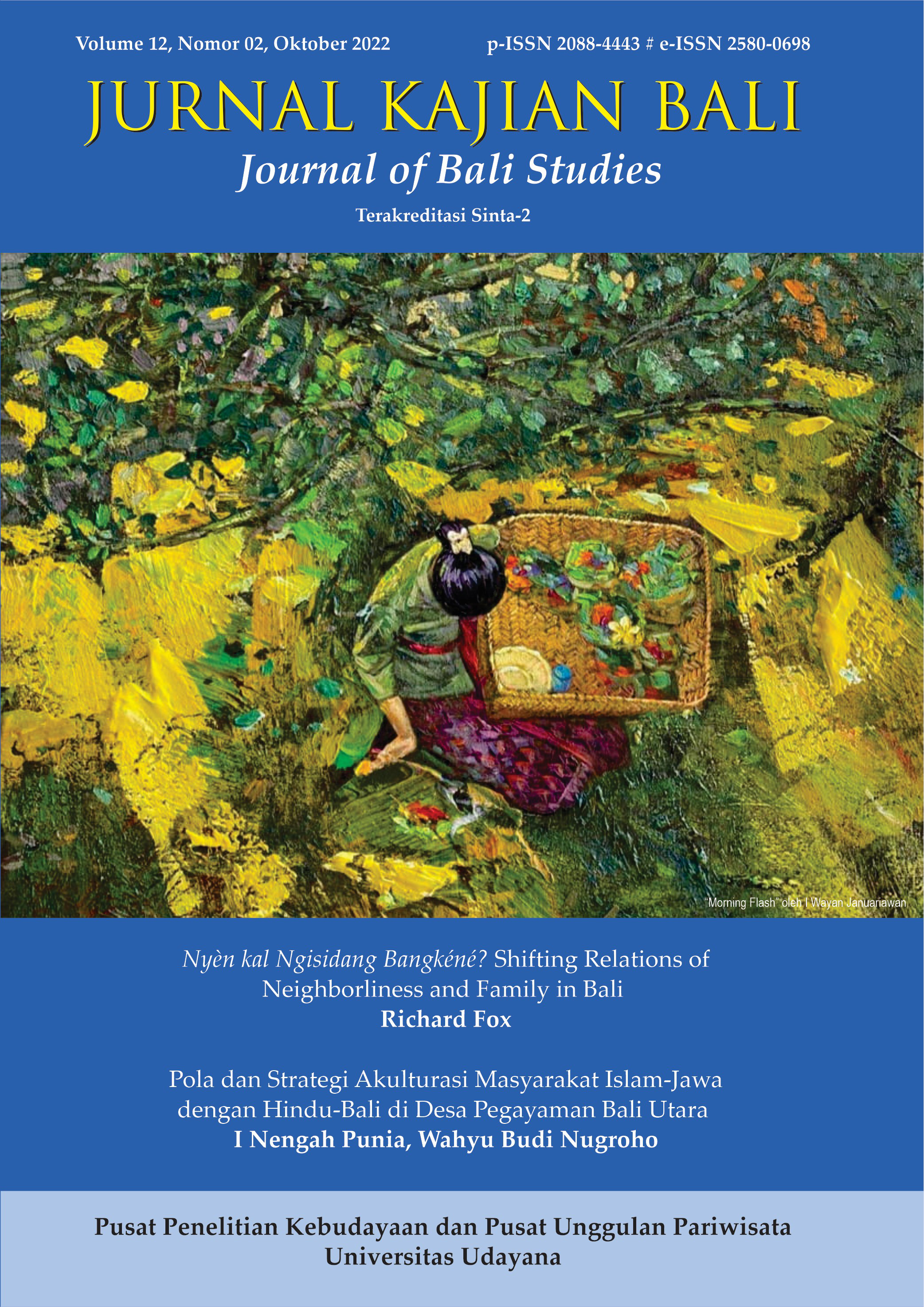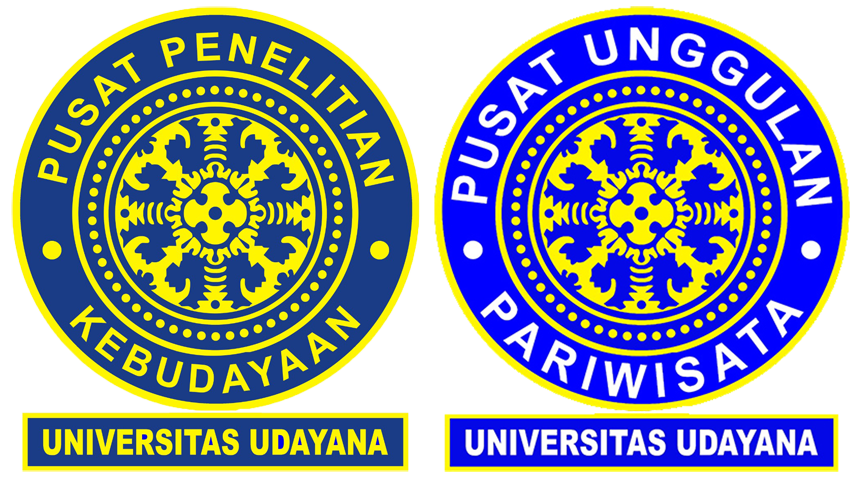Bali Tourism Research Trends: A Systematic Review, 1976–2022
Abstract
This research aims to systematically review of literature on Bali tourism from 1976 to 2022. This study employed a descriptive quantitative approach and utilizes 128 publications with the keyword “tourism in Bali” sourced from the Scopus database. This study concludes that the development of Bali tourism research has increased significantly. The contribution of Indonesian authors continues to dominate Bali tourism research. International authors play an essential role, especially in introducing the study of Bali tourism in the early thirty years. Furthermore, this review was successful in identifying the most commonly used topics, research approaches, and paradigms by researchers. This research, in particular, divides the evolution of the topics into four phases. The study’s sample of articles is restricted to those from the single database Scopus and solely in English. As a result, future research should be able to analyze articles from other sources, and in a broader range of languages.
Downloads
References
Arcana, K. T. P., & Wiweka, K. (2015). The Impact of Managing Sustainable Event and the Contribution to the Formation of Destination Image at Nusa Dua Resort, Bali. Jurnal Ilmiah Hospitality Management, 6(1), 43–48.
Arcana, K. T. P., & Wiweka, K. (2016a). Educational tourism’s product strategy at Batur global Geopark, Kintamani-Bali. International Research Journal of Management, IT & Social Sciences, 3(7), 40.
Arcana, K. T. P., & Wiweka, K. (2016b). The perception of local community toward tourist accommodation development, case study: village of seminyak, Bali. Journal of Business on Hospitality and Tourism, 2(1), 442–457.
Astawa, I. P., Sukawati, T. G. R., & Sugiartha, I. N. G. (2019). Developing a harmonious culture-based sustainable event model in Bali Tourism Village. Geo Journal of Tourism and Geosites, 25(2), 446–462.
Astuti, N. N. S., Ginaya, G., & Susyarini, N. P. W. A. (2019). Designing Bali tourism model through the implementation of tri hita karana and sad kertih values. International Journal of Linguistics, Literature and Culture, 5(1), 12–23.
Baker, K., & Coulter, A. (2007). Terrorism and tourism: The vulnerability of beach vendors’ livelihoods in Bali. Journal of Sustainable Tourism, 15(3), 249–266.
Booth, A., Sutton, A., & Papaioannou, D. (2016). Systematic approaches to a successful literature review.
Budhi, M. K. S., Lestari, N. P. N. E., & Suasih, N. N. R. (2022). The Recovery of The Tourism Industry in Bali Province Through The Penta-Helix Collaboration Strategy in The New Normal Era. Geo Journal of Tourism and Geosites, 40(1), 167–174.
Budiasa, I. W., & Ambarawati, I. (2014). Community based agro-tourism as an innovative integrated farming system development model towards sustainable agriculture and tourism in Bali. Journal of the International Society for Southeast Asian Agricultural Sciences, 20(1), 29–40.
Budiasa, I. W., Santosa, I. G. N., Ambarawati, I. G. A. A., Suada, I. K., Sunarta, I. N., & Shchegolkova, N. (2018). Feasibility study and carrying capacity of Lake Batur ecosystem to preserve tilapia fish farming in Bali, Indonesia. Biodiversitas Journal of Biological Diversity, 19(2), 563–570.
Buhalis, D. (2000). Marketing the competitive destination of the future. Tourism Management, 21(1), 97–116.
Cabasset, C. (1995). Tourisme culturel et tourisme de masse a Bali. Les Cahiers d’Outre-Mer, 48(191), 319–346.
Carlson, A. W. (1980). A bibliography of geographical research on tourism.
Cohen, E. (1972). Toward a sociology of international tourism. Social Research, 164–182.
Cohen, E. (1988). Authenticity and commoditization in tourism. Annals of Tourism Research, 15(3), 371–386.
Cukier, J., Norris, J., & Wall, G. (1996). The involvement of women in the tourism industry of Bali, Indonesia. The Journal of Development Studies, 33(2), 248–270.
Cukier, J., & Wall, G. (1994). Informal tourism employment: Vendors in Bali, Indonesia. Tourism Management, 15(6), 464–467.
Cukier, J., & Wall, G. (1995). Tourism employment in Bali: A gender analysis. Tourism Economics, 1(4), 389–401.
Dahlan, M. Z., Dewi, M. R., & Putri, V. O. (2021). The challenges of forest bathing tourism in Indonesia: A case study in Sudaji Village, Bali. IOP Conference Series: Earth and Environmental Science, 918(1), 012012.
Dann, G., Nash, D., & Pearce, P. (1988). Methodology in tourism research. Annals of Tourism Research, 15(1), 1–28.
Dolezal, C. (2019). Being in the field in Bali: A reflection on fieldwork challenges in community-based tourism research. In Tourism Ethnographies (pp. 97–111). Routledge.
Dolezal, C., & Novelli, M. (2020). Power in community-based tourism: Empowerment and partnership in Bali. Journal of Sustainable Tourism, 1–19.
Dress, G. (1979). Tourism as a development factor in tropical seas abroad exemplified by the case of the Isle of Bali in Indonesia.
Echtner, C. M., & Jamal, T. B. (1997). The disciplinary dilemma of tourism studies. Annals of Tourism Research, 24(4), 868–883.
Edelweis. (2021, March 16). Sejarah 16 Maret: Meletusnya Gunung Agung 58 Tahun Silam yang Membunuh Ribuan Jiwa. Merdeka.Com. https://www.merdeka.com/jatim/sejarah-16-maret-meletusnya-gunung-agung-58-tahun-silam-yang-membunuh-ribuan-jiwa-kln.html
Ernawati, H., Soeroso, A., Annisa, R. N., & Wibowo, F. X. S. (2018). Measuring Destination Image on Tourism River Area the Case of Gua Pindul. Journal of Education, Society and Behavioural Science, 28(2), 1–24. https://doi.org/10.9734/JESBS/2018/45216
Ernawati, N. M., Dowling, R., & Sanders, D. (2015). Tourists’ perceptions of community-based tourism products for sustainable tourism in Bali, Indonesia. In The Practice of Sustainable Tourism (pp. 117–134). Routledge.
Ernawati, N. M., Sanders, D., & Dowling, R. (2017). Host–guest orientations of community-based tourism products: A case study in Bali, Indonesia. International Journal of Tourism Research, 19(3), 367–382.
Esquivias, M. A., Sugiharti, L., Rohmawati, H., Setyorani, B., & Anindito, A. (2021). Tourism demand in indonesia: Implications in a post-pandemic period. Geo Journal of Tourism and Geosites, 37(3), 951–958.
Evren, S., & Kozak, N. (2014). Bibliometric analysis of tourism and hospitality related articles published in Turkey. Anatolia, 25(1), 61–80.
Gibbons, J. D., & Fish, M. (1989). Indonesia’s international tourism: A shifting industry in Bali. International Journal of Hospitality Management, 8(1), 63–70.
Goeldner, C. R., & Ritchie, J. B. (2007). Tourism principles, practices, philosophies. John Wiley & Sons.
Greenwood, D. J. (1989). Culture by the pound: An anthropological perspective on tourism as cultural commoditization., Ed. 2, 171–185.
Gurtner, Y. K. (2007). Crisis in Bali: Lessons in tourism recovery. Crisis Management in Tourism, 81–97.
Hadriani, N. L. G., Gelgel, I. P., & Wibawa, I. P. S. (2021). Environmental Conservation and Socio-Cultural Preservation Manifestations in Tourism Policy Development in Bali. Marketing, 12(8), 56.
Haldeman Davis, E. (2007). Building Bali Hai: Tourism and the (re) creation of place in Tahiti. Tourism: An International Interdisciplinary Journal, 55(1), 9–22.
Halim, D. K., & Ervina, E. (2021). Comparative Study: Perception on Sustainable Tourism of Urban and Rural Eco-Villages in Bali. IOP Conference Series: Earth and Environmental Science, 704(1), 012036.
HILDIKTIPARI. (2020). Memperkokoh Pariwisata Sebagai Ilmu: Menuju Pendidikan Tinggi Pariwisata Unggul.
Hitchcock, M. (2000). Ethnicity and tourism entrepreneurship in Java and Bali. Current Issues in Tourism, 3(3), 204–225.
Hitchcock, M. (2001). Tourism and total crisis in Indonesia: The case of Bali. Asia Pacific Business Review, 8(2), 101–120.
Hitchcock, M., & Putra, I. N. D. (2005). The Bali bombings: Tourism crisis management and conflict avoidance. Current Issues in Tourism, 8(1), 62–76.
Hollinshead, K. (2003). Symbolism in tourism: lessons from “Bali 2002”—lessons from australia’s dead heart. Tourism Analysis, 8(2), 267–295.
Howe, L. (2006). The changing world of Bali: Religion, society and tourism. Routledge.
Iswaratantra, G. W., Vipriyanti, N. U., Maba, W., & Surata, S. P. K. (2021). The economic, social and ecological potential of Gerokgak reservoir as a new tourism destination in north bali. Journal of Sustainability Science and Management, 16(7), 182–189.
Jafari, J. (1979). Tourism and the social sciences: A bibliography: 1970–1978. Annals of Tourism Research, 6(2), 149–194.
Jonker, J., & Pennink, B. (2010). The essence of research methodology: A concise guide for master and PhD students in management science. Springer Science & Business Media.
Kemenparekraf. (2021). Siap-siap! Kebijakan Work from Bali Mulai Berlangsung Juli—peduli covid19, kemenparekraf, baparekraf ri. Https://pedulicovid19.kemenparekraf.go.id/siap-siap-kebijakan-work-from-bali-mulai-berlangsung-juli/
Knopf, J. W. (2006). Doing a literature review. PS: Political Science and Politics, 39(1), 127–132.
Kontogeorgopoulos, N., Churyen, A., & Duangsaeng, V. (2015). Homestay tourism and the commercialization of the rural home in Thailand. Asia Pacific Journal of Tourism Research, 20(1), 29–50.
Lewis, J., & Lewis, B. (2008). Recovery: Taming the rwa bhineda after the Bali Bombings. In Rethinking Insecurity, War and Violence (pp. 206–219). Routledge.
Lewis, J., & Lewis, B. (2009). Bali’s silent crisis: Desire, tragedy, and transition. Lexington Books.
Liu, X., Zeng, Y., He, J., & Li, Z. (2021). Value cocreation research in tourism and hospitality: A comparative bibliometric analysis. International Journal of Contemporary Hospitality Management.
Lo, I. S., McKercher, B., Lo, A., Cheung, C., & Law, R. (2011). Tourism and online photography. Tourism Management, 32(4), 725–731.
MacCannell, D. (1976). The tourist: A new theory of the leisure class (With a New Introduction). Berkeley Los Angeles, Calif. London: University of California Press.
Mahagangga, G. A. O., Anom, I. P., Suryawan, I. B., Negara, I. K., Wulandari, I., & Ariwangsa, I. M. B. (2021). Tourism evolution and climate changed in Badung Regency, Bali, Indonesia. IOP Conference Series: Earth and Environmental Science, 724(1), 012093.
McIntosh, R. W., Goeldner, C. R., & Ritchie, J. B. (1995). Tourism: Principles, practices, philosophies. John Wiley and Sons.
McKean, P. F. (1976). Tourism, culture change, and culture conservation in Bali. Changing Identities in Modern Southeast Asia, 237–248.
McTaggart, W. D. (1980). Tourism and tradition in Bali. World Development, 8(5–6), 457–466.
Mohajan, H. K. (2018). Qualitative research methodology in social sciences and related subjects. Journal of Economic Development, Environment and People, 7(1), 23–48.
Naja, D. A., Suprayogi, S., Marfai, M. A., & Mardiatno, D. (2021). A study on the social network analyses of dive centers and sustainable tourism development in pemuteran Bali, Indonesia. Geo Journal of Tourism and Geosites, 36, 603–615.
Nugraha, P. G. W. S., Sugihantara, I. K., & Dewi, I. G. A. R. P. (2021). The Analysis of Carrying Capacity for Tourism Object in Melasti Beach Ungasan Bali. Art, Design, and Built Environment Conference Series, 1(1), 42–51.
Okumus, B., Koseoglu, M. A., & Ma, F. (2018). Food and gastronomy research in tourism and hospitality: A bibliometric analysis. International Journal of Hospitality Management, 73, 64–74.
Palácios, H., de Almeida, M. H., & Sousa, M. J. (2021). A bibliometric analysis of trust in the field of hospitality and tourism. International Journal of Hospitality Management, 95, 102944.
Pearce, D. G. (1979). Towards a geography of tourism. Annals of Tourism Research, 6(3), 245–272.
Picard, M. (1992). Bali: Tourisme culturel et culture touristique. Bali, 1–217.
Picard, M. (1993). “Cultural tourism” in Bali: National integration and regional differentiation., 71–98.
Picard, M. (2006). Bali: Pariwisata budaya dan budaya pariwisata. Kepustakaan Populer Gramedia.
Pickel-Chevalier, S. (2017). Le tourisme domestique indonésien: Une invention interculturelle. Le cas des pratiques touristiques indonésiennes à Bali et Java.
Pickel-Chevalier, S. (2018). Tourism in Bali and the Challenge of Sustainable Development. Cambridge Scholars Publishing.
Pickel-Chevalier, S., Bendesa, I. K. G., & Darma Putra, I. N. (2019). The integrated touristic villages: An Indonesian model of sustainable tourism? Tourism Geographies, 1–25.
Pickel-Chevalier, S., I.Komang. Gde, B., & Darma Putra, I. N. (2022). The Desa Wisata Terpadu: An Indonesian model of sustainable tourism? In Island tourism sustainability and resilience. https://hal.archives-ouvertes.fr/hal-03719340
Pickel-Chevalier, S., & Ketut, B. (2016). Towards sustainable tourism in Bali. A Western paradigm in the face of Balinese cultural uniqueness. Mondes Du Tourisme, Hors-série. https://doi.org/10.4000/tourisme.1187
Pickel-Chevalier, S., Violier, P., Parantika, A., & Maisonnave, E. (2018). Tourism as an agent of socio-spatial interculturation? Beach tourism practices in Bali and Java. LEspace Geographique, 47(2), 140–158.
Pickel-Chevalier, S., Violier, P., Parantika, A., & Sartika, S. N. P. (2017). The globalization of tourism in Bali: A shared destination for diversified practices and representations. In Tourism in Bali and the challenge of sustainable development. Cambridge Scholar Publishing.
Priyo Purnomo, E., Aditya, F., Teguh Fathani, A., Salsabila, L., & Rachmawatie, D. (2021). Penta-Helix Approach as a Strategy to Recovery Tourism in Bali Due to Covid-19 Pandemic. 2021. The 11th International Conference on Information Communication and Management, 122–127.
Putra, I., Adhika, I. M., & Yana, A. (2021). Reviving cultural tourism in kendran bali indonesia: Maintaining traditional architecture and developing community-based tourism. Civil Engineering and Architecture, 9(2), 328–338.
Putra, I. N. D., Verheijen, B., Ardika, I. W., & Yanthy, P. S. (2021). Affinity tourism and exotic tourism in Bali. The Chinese and Indian tourist gaze in the Garuda Wisnu Kencana Park. Journal of Tourism and Cultural Change, 19(4), 427–443.
Putra, I. N. D., & Paturusi, S. A. (2017). Metamorfosis pariwisata Bali: Tantangan membangun pariwisata berkelanjutan. Pustaka Larasan bekerja sama dengan Program Studi Magister Kajian Pariwisata.
Putra, I. N. D., & Hitchcock, M. (2012). Tourism, Development and Terrorism in Bali. Ashgate Publishing, Ltd.
Randolph, J. (2009). A guide to writing the dissertation literature review. Practical Assessment, Research, and Evaluation, 14(1), 13.
Riadil, I. G. (2020). Tourism industry crisis and its impacts: Investigating the Indonesian tourism employees perspectives’ in the pandemic of COVID-19. Jurnal Kepariwisataan: Destinasi, Hospitalitas Dan Perjalanan, 4(2), 98–108.
Rimba, A. B., Chapagain, S. K., Masago, Y., Fukushi, K., & Mohan, G. (2019). Investigating water sustainability and land use/land cover change (LULC) as the impact of tourism activity in Bali, Indonesia. IGARSS 2019-2019. IEEE International Geoscience and Remote Sensing Symposium, 6531–6534.
Rodenburg, E. E. (1980). The effects of scale in economic development: Tourism in Bali. Annals of Tourism Research, 7(2), 177–196.
Roth, D., & Sedana, G. (2015). Reframing Tri Hita Karana: From ‘Balinese Culture’to Politics. The Asia Pacific Journal of Anthropology, 16(2), 157–175.
Setyagung, E., Hani, U., Azzadina, I., Sianipar, C., & Ishii, T. (2013). Preserving Cultural Heritage: The Harmony between Art Idealism, Commercialization, and Triple-Helix Collaboration. American Journal of Tourism Management, 2(1), 22–28.
Subadra, I. N., & Hughes, H. (2022). Pandemic in paradise: Tourism pauses in Bali. Tourism and Hospitality Research, 22(1), 122–128.
Subawa, N. S., Widhiasthini, N. W., Astawa, I. P., Dwiatmadja, C., & Permatasari, N. P. I. (2021). The practices of virtual reality marketing in the tourism sector, a case study of Bali, Indonesia. Current Issues in Tourism, 24(23), 3284–3295.
Sudipa, N. (2020). Land and water carrying capacity in tourism area of Nusa Penida, Bali. International Journal of Scientific Research and Management (IJSRM), 8(2).
Sugiarto, E., Wiweka, K., & Priyanto, S. (2022). Pengantar Ilmu Pariwisata.
Sunarta, I. N., Mahendra, M. S., Wiranatha, A. S., & Paturusi, S. A. (2014). Tourism development impacts on water resources in northern kuta district of badung Bali. E-Journal of Tourism, 1, 160–175.
Sunarta, I. N., & Saiffuloh, M. (2022). Spatial variation of no2 levels during the covid-19 pandemic in the bali tourism area.
Sunarya, I. K. (2020). The Concept of Rwa Bhineda Kriya on the Island of Bali towards Jagadhita. Wacana Seni Journal of Arts Discourse, 19.
Suryawardani, I. I. G. A. O., Suryawardani, I. G. A. O., Suryawan, I. A. A. P. A., & Wiranatha, A. A. P. A. S. (2016). Strategy prioritization for sustainable tourism in bali indonesia focusing on local agricultural products analytical hierarchy process (ahp) approach. Journal of ISSAAS, 22(1).
Sutarya, I. G. (2021). The Potentials and Prospects of Yoga Pilgrimage Exploration in Bali Tourism. The International Journal of Religious Tourism and Pilgrimage, 8(8), 127–135.
Toh, R. S., Khan, H., & Erawan, S. D. (2004). Research note bomb blasts in bali: impact on tourism. Tourism Analysis, 9(3), 219–224.
Tribe, J. (1997). The indiscipline of tourism. Annals of Tourism Research, 24(3), 638–657.
Tribe, J. (2009). Philosophical Issues in Tourism, 3–25.
Van der Burg, L. (2013). Commoditization of the Ju/’hoansi Culture: Destroying Authenticity or Revitalizing Tradition? MA, University of Leiden.
Vorlaufer, K. (1999). Tourism and cultural change in Bali. Geographische Zeitschrift, 87(1), 29–45.
Wachyuni, S. S., & Wiweka, K. (2020). The changes in food consumption behavior: a rapid observational study of covid-19 pandemic. International Journal of Management, Innovation & Entrepreneurial Research, 6(2), 77–87. https://doi.org/10.18510/ijmier.2020.628
Wardana, I. M., Sukaatmadja, I. P. G., Yasa, N. N. K., & Setini, M. (2020). Comparative and competitives advantages: Perspective of rural tourism (study on tourism in the province of Bali Indonesia). Geo Journal of Tourism and Geosites, 33, 1493–1500.
Wigraha, N. A., Kustono, D., & Sudjimat, D. A. (2021). Bamboo Fiber Reinforced Composite in Sokasi Craft Making To Increase Commodity of Local Tourism Products in Bali. Review of International Geographical Education Online, 11(2), 280–290.
Wirawan, P. E., Sudjana, I. M., Semara, I. M. T., & Arianty, A. A. A. S. (2021). Portrait of International Backpacker Tourism During The Covid-19 Pandemic in Bali. Journal of Environmental Management & Tourism, 12(4), 886–894.
Wiweka, K. (2014). Analisis konsep tri hita karana pada daya tarik warisan budaya: Studi kasus puri agung karangasem, bali. Jurnal Master Pariwisata (JUMPA).
Wiweka, K., & Arcana, K. (2016). The impact of tourist accommodation development toward the socio-cultural aspects in the seminyak village, district of kuta, regency of badung, bali (in Perspective of the Local Community). Asia Tourism Forum 2016-the 12th Biennial Conference of Hospitality and Tourism Industry in Asia.
Wiweka, K., & Arcana, K. T. P. (2019). Rethinking the Theory of Tourism: What is Tourism System in Theoretical and Empirical Perspective? Journal of Business on Hospitality and Tourism, 5(2), 318–336.
Wiweka, K., & Utami, F. N. (2017). Komersialisasi unsur budaya kedaton sultan dan masjid sultan di ternate, Maluku Utara. Jurnal Sains Terapan Pariwisata, 2(1), 29–43.
Yudhari, I. D. A. S., Darwanto, D. H., Waluyati, L. R., & Mulyo, J. H. (2020). Multidimensional Scaling: Sustainability of Arabika Coffee Agro-Tourism in Kabupaten Bangli Bali. Journal of Environmental Management & Tourism, 11(6), 1455–1465.

This work is licensed under a Creative Commons Attribution 4.0 International License.



















